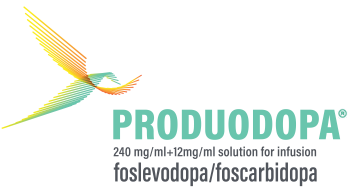This promotional material is intended for UK Healthcare Professionals (HCPs) experienced in the diagnosis and management of Parkinson’s disease only. Adverse event reporting can be found below
Some patients may not be suitable for PRODUODOPA. You are strongly advised to read the Prescribing information (PI), and Summary of Product Characteristics (SmPC) which can be found via the links above, to evaluate patient suitability for PRODUODOPA.
Adverse reactions reported in all Phase 3 studies in patients exposed to PRODUODOPA (379 patients with total exposure of 414.3 person-years, 230 subjects exposed for ≥6 months, 204 subjects exposed for ≥12 months) or data from DUODOPA (levodopa/carbidopa intestinal gel) based on treatment emergent frequencies, regardless of causality assigned1
The Duodopa prescribing information can be accessed here
| System Organ Class | Frequency | Adverse Reactions |
Infections and infestations | Very common (≥1/10) | Infusion site cellulitis Infusion site infection Urinary tract infection† |
Common (≥1/100 to <1/10)* | Infusion site abscess | |
| Blood and lymphatic system disorders | Common (≥1/100 to <1/10) | Anaemia† |
| Uncommon (≥1/1,000 to <1/100) | Leukopenia† Thrombocytopenia† | |
| Immune system disorder | Not known | Anaphylactic reaction†‖ |
Metabolism and nutrition disorders | Common (≥1/100 to <1/10) | Decreased appetite |
Psychiatric disorders | Very common (≥1/10) | Anxiety Depression Hallucination‡ |
| Common (≥1/100 to <1/10) | Abnormal dreams† Agitation† Confusional state Delusion Impulse control disorder Insomnia Paranoia Psychotic disorder Sleep attacks† Sleep disorder† Suicidal ideation | |
| Uncommon (≥1/1,000 to <1/100) | Completed suicide† Dementia† Disorientation† Dopamine dysregulation syndrome Euphoric mood† Fear† Libido increased† Nightmare† Suicide attempt† | |
| Rare (≥1/10,000 to <1/1,000) | Abnormal thinking† | |
Nervous system disorders | Common (≥1/100 to <1/10) | Cognitive disorder Dizziness Dizziness postural Dyskinesia Dystonia Headache Hypoaesthesia On and off phenomenon Paraesthesia Polyneuropathy§ Somnolence Syncope Tremor† |
| Uncommon (≥1/1,000 to <1/100) | Ataxia† Convulsion† Gait disturbance† | |
Eye disorders | Uncommon (≥1/1,000 to <1/100) | Angle closure glaucoma† |
Cardiac disorders | Common (≥1/100 to <1/10) | Heart rate irregular† |
Uncommon (≥1/1,000 to <1/100) | Palpitations | |
Vascular disorders | Common (≥1/100 to <1/10) | Hypertension |
Uncommon (≥1/1,000 to <1/100) | Phlebitis† | |
Respiratory, thoracic, and mediastinal disorders | Common (≥1/100 to <1/10) | Dyspnoea Oropharyngeal pain† |
Uncommon (≥1/1,000 to <1/100) | Dysphonia† | |
Rare (≥1/10,000 to <1/1,000) | Respiration abnormal† | |
Gastrointestinal disorders | Common (≥1/100 to <1/10) | Abdominal distension† Abdominal pain Constipation Diarrhoea Dry mouth Dysgeusia† Dyspepsia† Dysphagia† Flatulence† Nausea Vomiting |
| Uncommon (≥1/1,000 to <1/100) | Salivary hypersecretion† | |
| Rare (≥1/10,000 to <1/1,000) | Bruxism† Saliva discolouration† Glossodynia† Hiccups† | |
Skin and subcutaneous tissue disorders | Common (≥1/100 to <1/10) | Dermatitis contact† Hyperhidrosis† Pruritus Rash |
| Uncommon (≥1/1,000 to <1/100) | Alopecia† Erythema† Urticaria† | |
| Rare (≥1/10,000 to <1/1,000) | Sweat discolouration† Malignant melanoma† | |
Musculoskeletal and connective tissue disorders | Common (≥1/100 to <1/10) | Muscle spasms |
Renal and urinary disorders | Common (≥1/100 to <1/10) | Urinary incontinence Urinary retention |
| Uncommon (≥1/1,000 to <1/100) | Chromaturia† | |
| Rare (≥1/10,000 to <1/1,000) | Priapism† | |
General disorders and administration site conditions | Very common (≥1/10) | Infusion site erythema Infusion site reaction Infusion site nodule Infusion site oedema Infusion site pain |
| Common (≥1/100 to <1/10)* | Asthenia Fatigue Infusion site bruising Infusion site exfoliation Infusion site extravasation Infusion site haematoma Infusion site haemorrhage Infusion site induration Infusion site inflammation Infusion site irritation Infusion site mass Infusion site papule Infusion site pruritus Infusion site rash Infusion site swelling Malaise Oedema peripheral Pain† | |
| Uncommon (≥1/1,000 to <1/100) | Chest pain | |
Investigations | Common (≥1/100 to <1/10) | Amino acid level increased (Methylmalonic acid increased)† |
Injury, poisoning, and procedural complications | Very common (≥1/10) | Fall |
*Common adverse reactions pertaining to infusion site events included if ≥2%. †These adverse reactions were identified with DUODOPA intestinal gel as drug-related events. However, these events were not considered adverse reactions for PRODUODOPA. ‡Hallucination includes hallucination, hallucination visual, hallucination auditory, hallucination olfactory, hallucinations tactile, and hallucinations mixed. §Polyneuropathy includes neuropathy peripheral, polyneuropathy, decreased vibratory sense, peripheral sensory neuropathy, sensory disturbance, and sensory loss. ‖Based on post-marketing data.
Please refer to the PRODUODOPA Summary of Product Characteristics (SmPC) for further information on adverse events, contraindications and special warnings and precautions for use.
References
- PRODUODOPA (foslevodopa/foscarbidopa solution for infusion) Summary of Product Characteristics.
By clicking the link above you will leave the AbbVie Pro website and be taken to the eMC PI portal website
Adverse events should be reported. Reporting forms and information can be found at yellowcard.mhra.gov.uk.
Adverse events should also be reported to AbbVie on GBPV@abbvie.com
UK-PRODD-250317. Date of preparation: October 2025.








